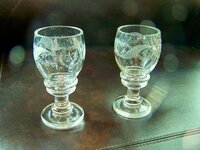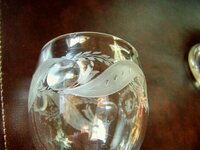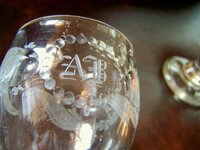tamrock
Gold Member
- Jan 16, 2013
- 14,929
- 29,747
- Detector(s) used
- Bounty Hunter Tracker IV
- Primary Interest:
- All Treasure Hunting
Picked these up at a yard sale. for 50 cent each. I'm wondering if they may be as old as the late 19th century or later 20th ? The lady said they came from stuff her x's grandparents had. To me the etchings, conical round polished cuts & mono look in the style of the Vic age and possible federal period?. I'm unsure myself as styles and shapes of wine glasses have been made the same for a couple century's now. They could even be as recent as the 20th, but I wouldn't say they'd be any later then the 1920's. Anyone here think they know how old they may be? They're heaver then more recent made glasses and they are hand spun imo. They're not lead crystal , based on the sound of a ping. It's more of a dink.











